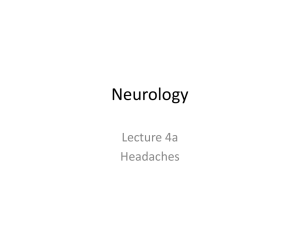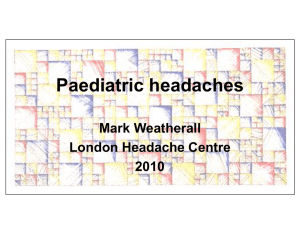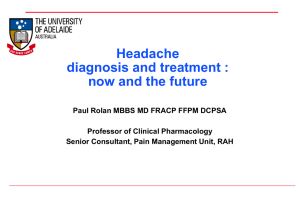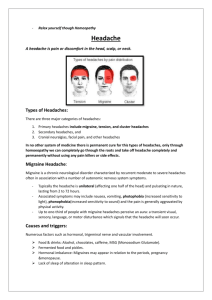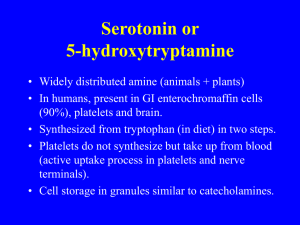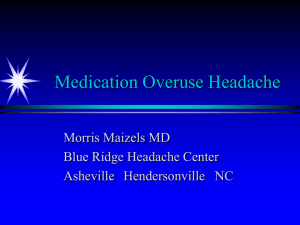Migraine Headaches
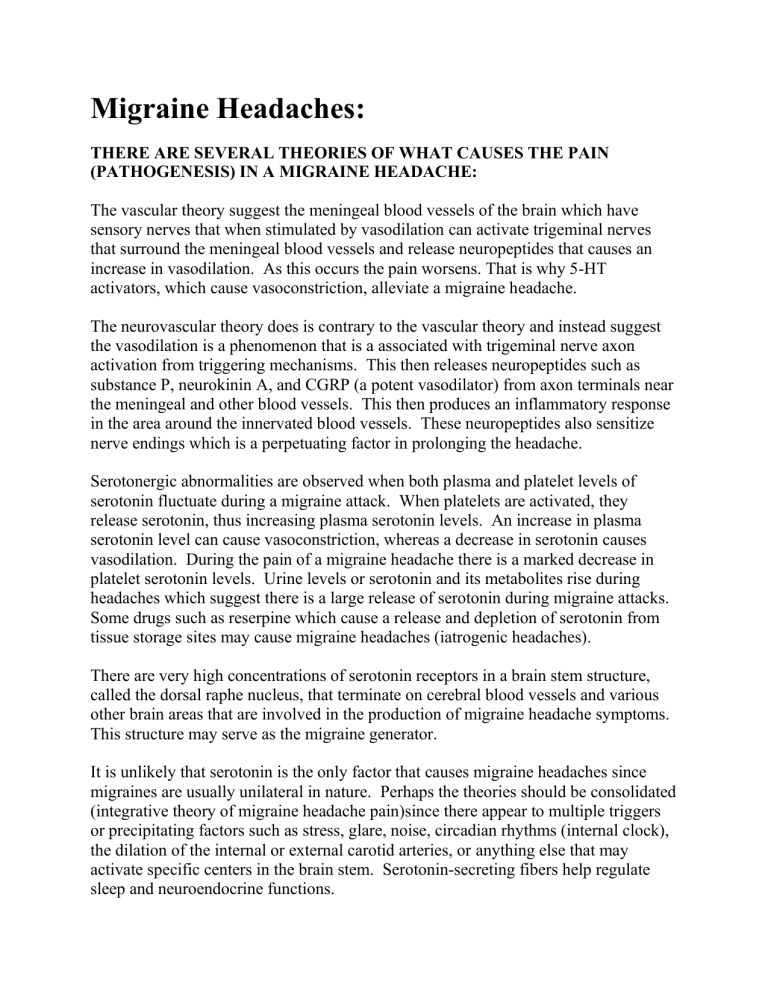
Migraine Headaches:
THERE ARE SEVERAL THEORIES OF WHAT CAUSES THE PAIN
(PATHOGENESIS) IN A MIGRAINE HEADACHE:
The vascular theory suggest the meningeal blood vessels of the brain which have sensory nerves that when stimulated by vasodilation can activate trigeminal nerves that surround the meningeal blood vessels and release neuropeptides that causes an increase in vasodilation. As this occurs the pain worsens. That is why 5-HT activators, which cause vasoconstriction, alleviate a migraine headache.
The neurovascular theory does is contrary to the vascular theory and instead suggest the vasodilation is a phenomenon that is a associated with trigeminal nerve axon activation from triggering mechanisms. This then releases neuropeptides such as substance P, neurokinin A, and CGRP (a potent vasodilator) from axon terminals near the meningeal and other blood vessels. This then produces an inflammatory response in the area around the innervated blood vessels. These neuropeptides also sensitize nerve endings which is a perpetuating factor in prolonging the headache.
Serotonergic abnormalities are observed when both plasma and platelet levels of serotonin fluctuate during a migraine attack. When platelets are activated, they release serotonin, thus increasing plasma serotonin levels. An increase in plasma serotonin level can cause vasoconstriction, whereas a decrease in serotonin causes vasodilation. During the pain of a migraine headache there is a marked decrease in platelet serotonin levels. Urine levels or serotonin and its metabolites rise during headaches which suggest there is a large release of serotonin during migraine attacks.
Some drugs such as reserpine which cause a release and depletion of serotonin from tissue storage sites may cause migraine headaches (iatrogenic headaches).
There are very high concentrations of serotonin receptors in a brain stem structure, called the dorsal raphe nucleus, that terminate on cerebral blood vessels and various other brain areas that are involved in the production of migraine headache symptoms.
This structure may serve as the migraine generator.
It is unlikely that serotonin is the only factor that causes migraine headaches since migraines are usually unilateral in nature. Perhaps the theories should be consolidated
(integrative theory of migraine headache pain)since there appear to multiple triggers or precipitating factors such as stress, glare, noise, circadian rhythms (internal clock), the dilation of the internal or external carotid arteries, or anything else that may activate specific centers in the brain stem. Serotonin-secreting fibers help regulate sleep and neuroendocrine functions.
There are probably connection from lower brain stem areas with the hypothalamus which may be responsible for the prodromal signs and symptoms prior to the onset of pain which include mood changes, food cravings, drowsiness, thirst, and yawning and may occur as long as one day before the headaches pain begins.
Regardless of the triggering the dilation of meningeal vessels contributes to pain generation.
There are several clinically relevant triggering factors that have clinical solutions or effective home care:
Dietary Changes:
It is important to have regular meals to stabilize glucose levels. You should avoid foods which contain tyramine, nitrates, nitrites, monosodium glutamate, and alcohol, and caffeine. These have direct action on vasomotor tone. The patient should be tested for food sensitivities and remove food from the diet that produce headache triggers such as histamines which cause vasodilation.
Detoxification:
Toxic metals in the body are known to effect the nervous system and be a triggering factor to headaches. Toxic metals should be tested for and removed with chelation therapy. Since there is daily exposure to toxins that can enter the body and trigger headaches a detoxification program should be maintained with diet, Epson salt baths, and saunas.
Circadian Rhythms:
Circadian rhythms have normal physiological cycles during the day and may degraded or disrupted with sleep deprivation, disruption of normal clock cycles due to traveling across time zones (jet lag) and can cause circadian disrhythmia. This leads to disturbance of sleep cycles and fatigue. Fatigue is also a predisposing factor to headache pain. Use of transcranial microcurrent bioresonance therapy can resynchronize these disrupted or degraded clocks.
Sleep:
Stable sleep patterns (e.g., going to bed and arising at the same time), are important to preventing migraine headache pain. REM sleep inhibits the release of serotonin from the dorsal raphe nucleus, and sleep may abort a migraine attack by inhibiting the serotonin-mediated stimulation of the trigeminovascular system.
Avoid stimulants and have regular exercise:
Avoid ischemic provoking agents such as nicotine. Smoking tobacco is not the only source of nicotine. Chewing tobacco and gums containing nicotine are used to withdraw or avoid the damage that smoking does to the lungs. But nicotine in any form is very harmful because its blood vessel constrictive properties rob the whole body of needed nourishment. Nicotine tightens blood vessel and restricts blood flow thereby causing ischemia. Ischemia is hypoxia (shortage of oxygen). When it is in the brain, neurons release adenosine in an attempt to restore oxygen homeostasis, the balance between demand for and supply of oxygen. Adenosine inhibits the release of excitatory neurotransmitters, so damps nerve firing and thereby decreases oxygen demand. At the same time, adenosine also dilates arteries in the head and neck, in an attempt to keep enough blood and oxygen flowing to the brain to maintain consciousness. But adenosine has other effects besides vasodilation: it also causes pain by binding to adenosine receptors on sensory neurons in the head. It is theorized that adenosine may be a main trigger to vasodilation of cerebral vessels associated with migraine headache pain. Regular exercise improves blood flow and thus reduces ischemia.
Avoid cold weather and application of cold packs.
Caffeine:
Caffeine is a neurotoxic alkaloid that disrupts intricate nervous mechanisms by occupying and blockading adenosine receptors embedded in the surface membranes of neurons (nerve cells). Adenosine is called a neuromodulator, because it modulates, or controls, the activity of neurotransmitter molecules including serotonin, norepinephrine, dopamine, and acetylcholine. Adenosine's effect on the region of the body it is in. Adenosine can have opposite effects in different parts of the nervous system. Overall, adenosine acts as a tranquilizer, inhibiting nerve firing by inhibiting the release of excitatory neurochemicals. Centrally, in the brainstem and spinal cord, adenosine is a painkiller, but peripherally, in the outer reaches of the nervous system, it causes pain. Adenosine applied to the skin causes localized pain and vasodilation.
Adenosine dilates blood vessels in the head and neck therefore caffeine constricts blood vessels in the head and neck, and increases the release of excitatory neurochemicals, so there is increased the rate of nerve firing (depolorization). The concentration of adenosine in the head and neck is increased above normal during migraine episodes.
Caffeine can both trigger and relieve a migraine headache. One theory that attempts to explain why caffeine relieves headaches is that caffeine works by constricting blood vessels. Blood vessels in the head and neck are dilated during a migraine episode, and
caffeine does indeed constrict blood vessels in the head and neck. However the fact that caffeine constricts blood vessels of the head and neck should cause one to avoid it since the prodromal phase before the migraine headache is characterized by vasoconstriction.
Caffeine is a common ingredient in many prescription and over-the-counter headache medications. Caffeine additives make pain-relievers 40% more effective in treating headaches. Caffeine also helps the body absorb headache medications more quickly, bringing faster relief.
Hormonal Changes Can trigger a migraine headache:
Migraine headaches occur more frequently in adult women than in men. They are common and can be debilitating. Contemporary medical opinion relates headaches in women to the female sex hormones estrogen and progesterone. Women have several hormonal milestones in their life including menarche, pregnancy, contraceptive use, and menopause. The frequency and intensity of headaches may be associated each of these events levels of sex hormones change.
The central nervous system has serotonin and opiod receptors that are affected by estrogen and progesterone. Serotonin is a neurotransmitter. It is released intracerebrally in response to trigger factors and can cause vascular dilation. Both serotonin and estradiol play a role in headaches in women. High estradiol levels are associated with high levels of serotonin and, conversely, low levels of serotonin are correlated with low levels of estrogen.
During pregnancy headaches usually decrease because estradiol and serotonin levels are high. Headaches usually increase during ovulation, menstruation, and birthing, when there is a decline in estradiol and inhibitory serotonin. This falling levels of estradiol appears to be an essential component in changes in serotonin levels and, consequently, changes in headache patterns. There is a difference with spontaneous menopause when estradiol levels decline and when there is gradual onset with continued cycling of hormone levels. Increased headache appear to be associated more with the cycling of hormone levels rather than a continuous state of decline.
It is the declining high estradiol levels that seem to cause a decline in serotonin. The same mechanism causes headaches when using a cycling postmenopausal estrogen replacement product. The primary trigger for menstrual migraine appears to be the withdrawal of estrogen rather than sustained high or low levels. However, sustained high or low estrogen levels (as in pregnancy or menopause) also may affect headaches. Serotonin receptors play a key role in migraine. Peripheral levels of
serotonin and estradiol are also associated with migraine. Sex steroids are neurosteroids able to directly influence neural morphology and function. Triggers for headaches in sensitive persons lead to intracerebral release of neurotransmitters such as serotonin, which in turn stimulates dilation of intracranial extracerebral vessels.
When the vessels are dilated, the surrounding perivascular neurons are stimulated, which causes the painful part of a headache. Consequently, when serotonin levels drop, there is an increased susceptibility to headache. During the menstrual cycle, high estradiol levels are not associated with headaches, but periods of declining estradiol levels, such as ovulation and menstruation, are associated with an increased incidence of headache. Serotonin levels have been found to drop in both migraine and tension-type headaches. This peak and trough scenario also explains why headaches worsen after discontinuing oral contraceptives or estrogen replacement therapy.
Although migraines headaches usually improve in 67% of women undergoing a natural menopause and in 37% of women undergoing a surgical menopause, that still leaves a significant number of women who continue to have migraine headaches or have increased headaches in menopause.
Women using hormone therapy (HT) have variable responses with regard to the frequency of headaches. Laboratory data is not a sufficient predictor of which women will adversely be affected by hormone therapy. A history of migraines or difficulty with pregnancies, is a strong predictors of more intense headache at menopause.
Women who do not have a favorable course of migraine in the postmenopausal period, will many time have a favorable response with careful management using hormone replacement therapy that is bio-identical and properly balanced.
Psychological factors, such as coping with stress, seem to play a fundamental role.
TREATMENT OF HEADACHES:
Treatment of headaches begins with correct diagnosis and identification of the etiology of the problem. The most important component of the evaluation of headache is a detailed history documenting location, frequency, duration, and aggravating/alleviating factors. Overuse of medications that can lead to rebound headaches should be investigated. Physical examination includes vital signs, cardiovascular assessment, and auscultation for bruits over the scalp and carotids. The temporomandibular joint should be assessed for clicking while inspection for bruises, masses or nodes, whereas palpating the head and neck for tenderness should be included in the examination. A neurological examination, including assessment of the cranial nerves and reflexes, should be performed to rule out pathological findings.
Conventional medical approaches uses drugs such as beta blockers, calcium channel blockers, antidepressants, serotonin reuptake inhibitors (SSRIs), and anticonvulsants may effectively prevent migraines. Nonsteroidal anti-inflammatory drugs (NSAIDs) are effective for some women in both over-the-counter and prescription strengths.
Common options include naproxen (Aleve, Anaprox, or Naprelan), meclofenamate
(generic), flurbiprofen (Ansaid), and ibuprofen (Motrin). Medications used to treat migraines have many systemic effects and should therefore not be the first choice of treatment. Contraindications and instructions should be completely understood before prescribing. This is particularly important in older women who may have co-morbid conditions that can be adversely affected by particular treatments. Rebounding is another very important factor to consider when deciding to take medications for headaches. It is known that even Tylenol has rebound triggering of headaches when the patient discontinues its use.
Hormone Therapy must have the correct balance and from sources that don't cause triggering of migraine headache pain. Many women, when tested, show they have sensitivity to soy beans. This is the main source of hormone replacement therapy used by most pharmacies. Patients who are sensitive to soy can release a vasodilator when exposed to products made from soy. The Optihealth clinic does not prescribe hormones that is derived from soy.
Headache associated with Hormone Therapy may be improved by changing from a cycling to a daily estrogen/progestin product or avoiding the medication-free week. It is also important use high enough levels of progesterone to activate estrogen so it can regulate serotonin levels. This level may be higher than many pharmacies will provide. A knowledgeable compounding pharmacist will provide these necessary levels and provide the necessary balance.
Chiropractic or Osteopathic manipulation therapy and Acupuncture can reduce triggering factors in migraine headache pain. Electro Acuscope therapy is very effective in reducing sensitivity and provoking factors and is used to effect a range of triggering factors including upper cervical pain secondary to injury, temporomandibular joint (TMJ) pain, head and neck myalgias, tissue inflammation, cell synchronization, biofeedback, etc. Neck and jaw exercises may also be helpful for patients who have migraines.
2007© Copyright OptihealthGuide.com
